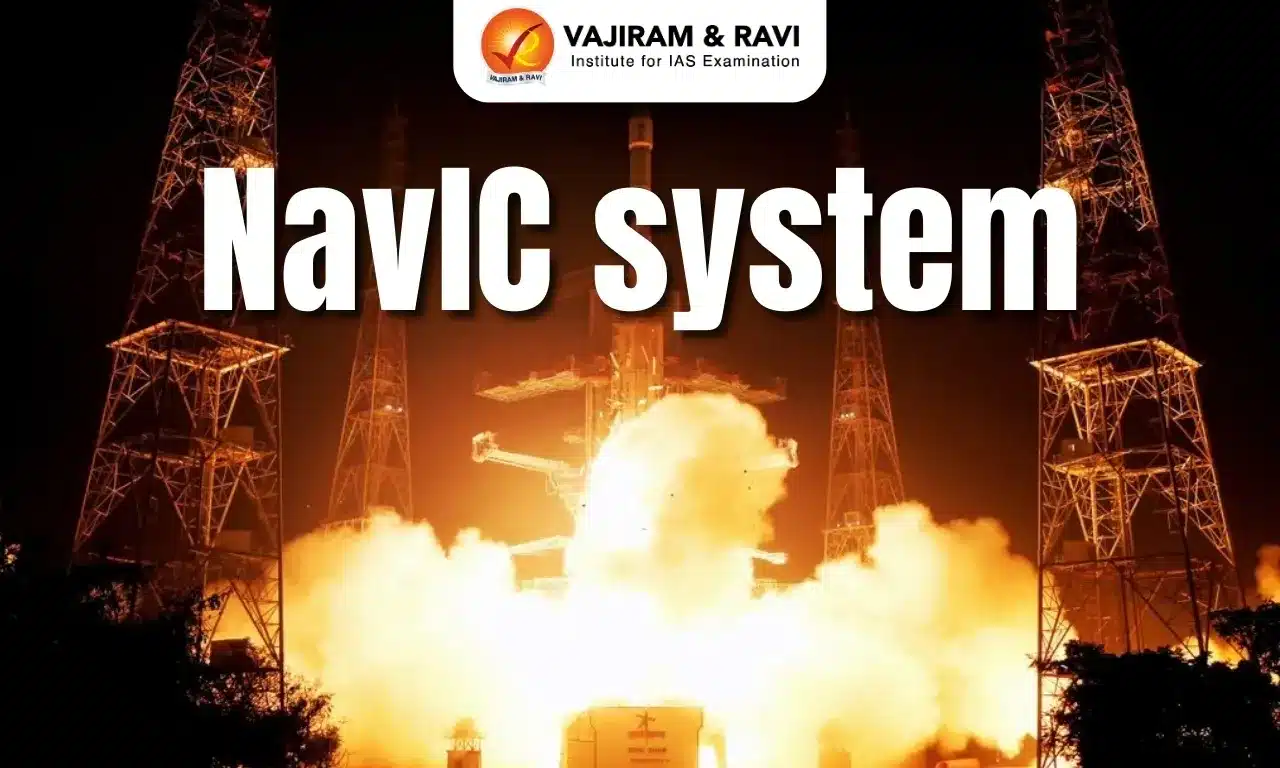What’s in Today’s article?
- NavIC system Latest News
- Failures in IRNSS Satellites
- Current Operational Status of NavIC Satellites
- Importance of the NavIC System for India
- Future Plans for Expansion
- NavIC system FAQs
NavIC system Latest News
- India’s NVS-02 navigation satellite partially failed on February 2 due to engine non-firing, marking another setback for the Indian Regional Navigation Satellite System (IRNSS), or NavIC.
- Conceived after the 1999 Kargil War, NavIC aimed to establish a seven-satellite constellation by 2016 for defence and civilian use. However, only five of the 11 satellites launched since 2013 remain fully operational.
- Despite ISRO declaring the constellation complete in 2016, failures and replacements have plagued the ₹2,250 crore program.
Failures in IRNSS Satellites
- Atomic Clock Malfunctions (2016 Onward)
- Failures reported in rubidium atomic clocks used in IRNSS and ESA’s Galileo GNSS.
- Each IRNSS satellite has three atomic clocks.
- In July 2016, ISRO confirmed all clocks on IRNSS-1A had stopped working.
- Despite this, ISRO stated the navigation system’s overall performance remained unaffected.
- Clocks in IRNSS-1C, 1D, 1E, and 1G also developed issues over time.
- Failures reported in rubidium atomic clocks used in IRNSS and ESA’s Galileo GNSS.
- Satellite Launch and Deployment Failures
- IRNSS-1H, launched in 2017 to replace IRNSS-1A, failed as its heat shield did not detach.
- The latest satellite, IRNSS-1K (NVS-02), suffered an engine failure in 2025, leaving it in a sub-optimal orbit.
- Overall Impact
- Out of 11 IRNSS satellites launched, six have faced failures, affecting India’s indigenous navigation system.
Current Operational Status of NavIC Satellites
- ISRO’s 2023-24 annual report says that following the launch of NVS-01 on May 28, 2023, five NavIC satellites are operational – IRNSS-1B, 1C, 1F, and 1I, and NVS-01 (IRNSS-1J).
- However, according to some estimates, 1C is only partially operational due to the presence of the old series of atomic clocks that were reported to be malfunctioning.
- Satellite Generations and Clock Issues
- First-generation IRNSS satellites (1H and 1I) carried modified European clocks.
- Next-generation satellites (NVS-01 and NVS-02) use a mix of indigenous and foreign clocks.
- NVS-02 (IRNSS-1K) failed due to an engine malfunction.
Importance of the NavIC System for India
- Key Services Provided by NavIC
- Standard Positioning Service (SPS): For general and commercial use.
- Restricted Service (RS): For defense forces.
- Offers positioning accuracy better than 20 meters across India and up to 1,500 km around it, with dual-frequency capabilities in L5 and S band.
- Strategic Importance for Defense
- NavIC ensures reliable positioning data critical for defense applications, unlike global systems such as GPS, which have military-encrypted services primarily for US and allied forces.
- Global navigation systems (GPS, GLONASS, Galileo, Beidou, QZSS) are mainly developed for military use, and NavIC provides India with independent and secure navigation.
- Commercial and Consumer Adoption
- For NavIC to become widespread, ISRO plans to partner with commercial service providers, including mobile phone and vehicle manufacturers.
- Qualcomm, a mobile chipmaker, agreed to incorporate NavIC support in some chipsets in December 2023.
Future Plans for Expansion
- ISRO intends to launch three more second-generation satellites (NVS-03, 04, 05) to enhance the NavIC system and ensure continuity of services, despite setbacks like the NVS-02 engine failure.
NavIC system FAQs
Q1. What is the difference between NavIC and IRNSS?
Ans. NavIC is the operational name of the Indian Regional Navigation Satellite System (IRNSS), providing regional positioning services.
Q2. How many satellites are there in IRNSS?
Ans. IRNSS, or NavIC, aims for seven satellites but currently operates only five fully functional satellites.
Q3. What is the purpose of IRNSS?
Ans. IRNSS provides accurate positioning data for both defense and civilian uses within India and surrounding regions.
Q4. Is NavIC available for public use?
Ans. Yes, NavIC’s Standard Positioning Service (SPS) is available for public and commercial use, providing accurate positioning.
Q5. Is NavIC better than GPS?
Ans. NavIC is more reliable for India, offering regional coverage with higher accuracy, unlike GPS, which is US-centric.
Last updated on December, 2025
→ Check out the latest UPSC Syllabus 2026 here.
→ Join Vajiram & Ravi’s Interview Guidance Programme for expert help to crack your final UPSC stage.
→ UPSC Mains Result 2025 is now out.
→ UPSC Notification 2026 is scheduled to be released on January 14, 2026.
→ UPSC Calendar 2026 is released on 15th May, 2025.
→ The UPSC Vacancy 2025 were released 1129, out of which 979 were for UPSC CSE and remaining 150 are for UPSC IFoS.
→ UPSC Prelims 2026 will be conducted on 24th May, 2026 & UPSC Mains 2026 will be conducted on 21st August 2026.
→ The UPSC Selection Process is of 3 stages-Prelims, Mains and Interview.
→ UPSC Result 2024 is released with latest UPSC Marksheet 2024. Check Now!
→ UPSC Prelims Result 2025 is out now for the CSE held on 25 May 2025.
→ UPSC Toppers List 2024 is released now. Shakti Dubey is UPSC AIR 1 2024 Topper.
→ UPSC Prelims Question Paper 2025 and Unofficial Prelims Answer Key 2025 are available now.
→ UPSC Mains Question Paper 2025 is out for Essay, GS 1, 2, 3 & GS 4.
→ UPSC Mains Indian Language Question Paper 2025 is now out.
→ UPSC Mains Optional Question Paper 2025 is now out.
→ Also check Best IAS Coaching in Delhi

















